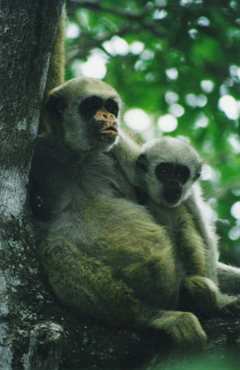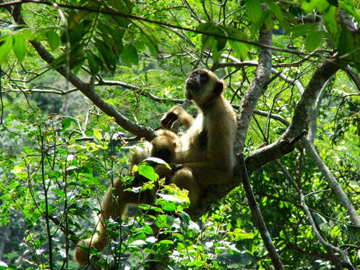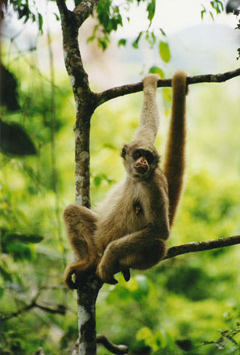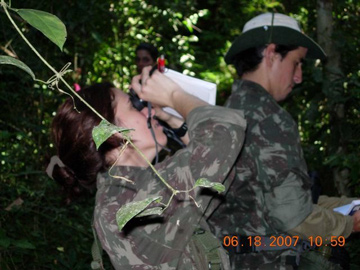An interview with primate researcher Dr. Karen Strier
Conservation of muriqui and Atlantic Forest requires ongoing support
In Brazil’s Threatened Atlantic Forest a Family of Primates Displays ‘Egalitarian’ Behavior, Surviving without Hierarchies or Dominance
|
|
When one thinks of Brazil and tropical forest, images of the Amazon inevitably appear. Yet there is another tropical forest in Brazil, smaller and lesser-known, yet just as biologically rich as the Amazon. This coastal, as opposed to riparian, forest may be even more threatened today than the Amazon.
The Atlantic Forest stretches in patches along Brazil’s east coast. It is a biological paradise that barely survived the previous centuries. From the Portuguese and Spanish colonization to the present day, this ecosystem has been under threat. Widespread deforestation began with sugarcane plantations and demands for timber; later coffee production took its toll. Currently, less than ten percent of the original forest remains intact and what exists is fragmented. The forest faces new threats by Brazil’s growing urban population. Both the megacities of Sao Paulo (the world’s fifth largest city) and Rio de Janiero have emerged and grown up in what used to be tropical forest.

Muriquis in Brazil. Photo by Carla B. Possamai |
What has survived of the Atlantic Forest contains an immense richness of flora and fauna, much of it endemic and rare. 20,000 species of plants have been identified in the Atlantic Forest, nearly half of which are endemic; the forest also contains 72 mammals, 94 reptiles, 282 amphibians, and 144 birds found no-where else in the world. Many species, including 2 birds and a lion tamarin were discovered as recently as the 1990s. Among these biological marvels some notables the world’s most endangered sloth, the maned sloth, named for its shaggy long fur; the Brazilian arboreal mouse known from only two specimens; and the Maximilian snake-necked turtle, one of Brazil’s smallest turtles, growing no longer than 8 inches.
Yet, perhaps the greatest treasure in the Atlantic Forest is its primates. Two primate genera exist only in this fragmented ecosystem. The first is the lion tamarin, which includes four separate species; these sunset-orange primates are strikingly different from their Amazonian relations. The forest also boasts South America’s largest primates, the Southern and Northern Muriqui. The muriqui are unique among all primates, because they are not territorial and do not display aggressive behavior. The IUCN has classified the Southern Muriqui as endangered, while the Northern Muriqui is critically endangered. Dr. Karen Strier has studied the Northern Muriqui in the field for twenty-five years. A professor of zoology and anthropology at the University of Madison Wisconsin, she is the author of Faces in the Forest: the Endangered Muriqui Monkeys of Brazil and a new textbook entitled Primate Behavioral Ecology.
AN INTERVIEW WITH DR. KAREN STRIER
Mongabay: What is the focus of your research?
Strier: My research is aimed at understanding primate behavioral ecology from a comparative perspective, and I am especially interested in understanding population variation and the ways in which demographic and ecological conditions affect behavior. Most of my work now is focused on how scientific knowledge can contribute to informed conservation efforts.
Mongabay: How did you become interested in this area? What is your background?

Dr. Karen Strier |
Strier: Studying wild primates was a way to combine my interests in animal behavior, nature, and human evolution. I was interested in anthropology, biology, and psychology as an undergraduate, and was fortunate to obtain a position as a field assistant on the Amboseli Baboon project during my junior year of college. I decided to focus on biological anthropology for my PhD.
Mongabay: Do you have any advice for students hoping to become scientists?
Strier: Take as many science courses as you can, gain as much research experience as possible, and keep searching for an area of study that you are passionate about.
Mongabay: What is you favorite place in the tropics?
Strier: My long-term field site in southeastern Brazil, where I have been studying northern muriqui monkeys for more than 25 years.
Mongabay: Having spent 25 years doing field research in the Atlantic Forest, can you describe the changes you have seen in the forest during that time?
Strier: The Atlantic Forest already underwent extensive deforestation during the early 1900s, and by the time I made my first trip there in 1982, there was only about 6% of the original Atlantic Forest remaining. Over the years, I have watched the Brazilian government and NGOs make enormous efforts to protect the remaining Atlantic Forest.
Mongabay: What do you see as the greatest threats to the Atlantic Forest?
Strier: The greatest threats continue to be how fragmented the original forest has become. Small fragments are more vulnerable to edge effects, and the smaller populations of wildlife they support are more vulnerable to extinction. Hunting is not a problem in the area I work, but it is in other parts of the remaining Atlantic Forest.
Mongabay: Do you see climate change as a particular threat to the rainforest?
Strier: Yes, especially in the Atlantic forest, which has already been so reduced in size and fragmented.
Mongabay: What must be done to ensure conservation of the Atlantic forest?
Strier: There is a strong conservation ethic in southeastern Brazil, and this has helped protect the remaining Atlantic forest. These efforts need to be maintained and supported, so that the resources necessary for conservation, and for offering alternatives to the local human communities, are available.
Mongabay: What is the difference between the northern and southern muriqui?

Muriquis in Brazil. Photo by Carla B. Possamai |
Strier: Northern muriquis are found only in about a dozen forest fragments in the states of Minas Gerais, Espirito Santo, and possibly southern Bahia. Southern muriquis occur in the states of Rio de Janeiro, Sao Paulo, and Parana. Northern muriquis have dispigmentation on their faces, whereas southern muriquis are usually less dispigmented, with black faces. Some researchers have also pointed to the presence absence of a residual thumb, but this may turn out to be more variable than previously thought.
Mongabay: What drew you to studying the northern muriqui?
Strier: The muriquis I study were good models for evaluating the ways in which primate diets affect their social behavior and grouping patterns. On the one hand, they have teeth and jaws suited for consuming a lot of abundant leaves; on the other hand they travel by rapid, suspensory locomotion, which is usually associated with far-ranging foraging for dispersed fruit sources. This model of food–social organization had been developed from the perspective of Old World primates. I wanted to determine whether muriquis were mainly fruit or leaf eaters, and depending on the answer, whether their social behavior conformed with the predictions at the time.
 Muriqui in Brazil. Photo by Carla B. Possamai |
It turns out that they prefer fruit, but are capable of supplementing their diets with leaves when fruits are seasonally scarce. This ability is probably one of the reasons why they have survived despite their altered habitats. Their social behavior was surprising in that males and females are egalitarian, and there is no evidence of dominance hierarchies, either among females or among males or between males and females. Females disperse from their natal groups, and males are unusually peaceful and tolerant toward one another, which may reflect their close kinship.
Other the years, with my students and collaborators, we have also investigated muriqui reproductive biology, and I am now especially interested in understanding the factors that affect their population dynamics as well as individual life histories. Muriquis have slow, almost ape-like life histories, which makes them even more interesting from a comparative perspective. At the same time, because they are so critically endangered, understanding their behavior, ecology, reproductive patterns, and life histories can contribute to assessing the viability of populations and ultimately, to their conservation.
Mongabay: What are the causes of the northern muriqui being critically
endangered?
Strier: The greatest threats to northern muriquis are the small sizes of the remaining populations, which are also isolated from one another. We now know of only three forests that support more than 200 muriquis, one of which is where my research has been based. Some of the other populations are much smaller, and therefore at greater risk of genetic and demographic problems that could lead to their extinction.
Mongabay: What is being done to save the species?
Strier: The northern muriquis have been fortunate to have become flagships for conservation in Brazil. The Brazilian government has supported a number of conservation initiatives on their behalf, and there is a large team of Brazilian and international researchers, conservationists, and NGOs all involved in working to save the species. Continued prohibitions on hunting and increased habitat protection are important. There are also a number of management plans underway, including the development of forest corridors to link isolated populations, and in two cases, isolated females from other populations were successfully translocated into new populations to stimulate population growth and gene flow.
Mongabay: How do you view the state of global primate conservation today?
What more should be done?

Dr. Strier’s students in training |
Strier: I think that great progress has been made in many parts of world, ranging from the establishment of national parks where primates are protected, to the protection of private properties, to effective local conservation education programs. My experience in Brazil has shown me that it is possible to accomplish a great deal in just a few decades when researchers and conservationists work together on both international and local scales. Human population growth continues to put humans into competition with primates, whether for their habitat or for food, and alternative economic solutions still need to be found and implemented in many parts of the world. Climate change poses an even more global problem, as it will impact the forests upon which primates depend, and the human populations that live near these forests. More education and economic incentives for conservation, and more research to identify priorities as well as solutions, are needed to resolve these issues. Addressing these problems will require commitments from the international community, including government leaders and the public, and we can’t afford to lose any more time than we already have.